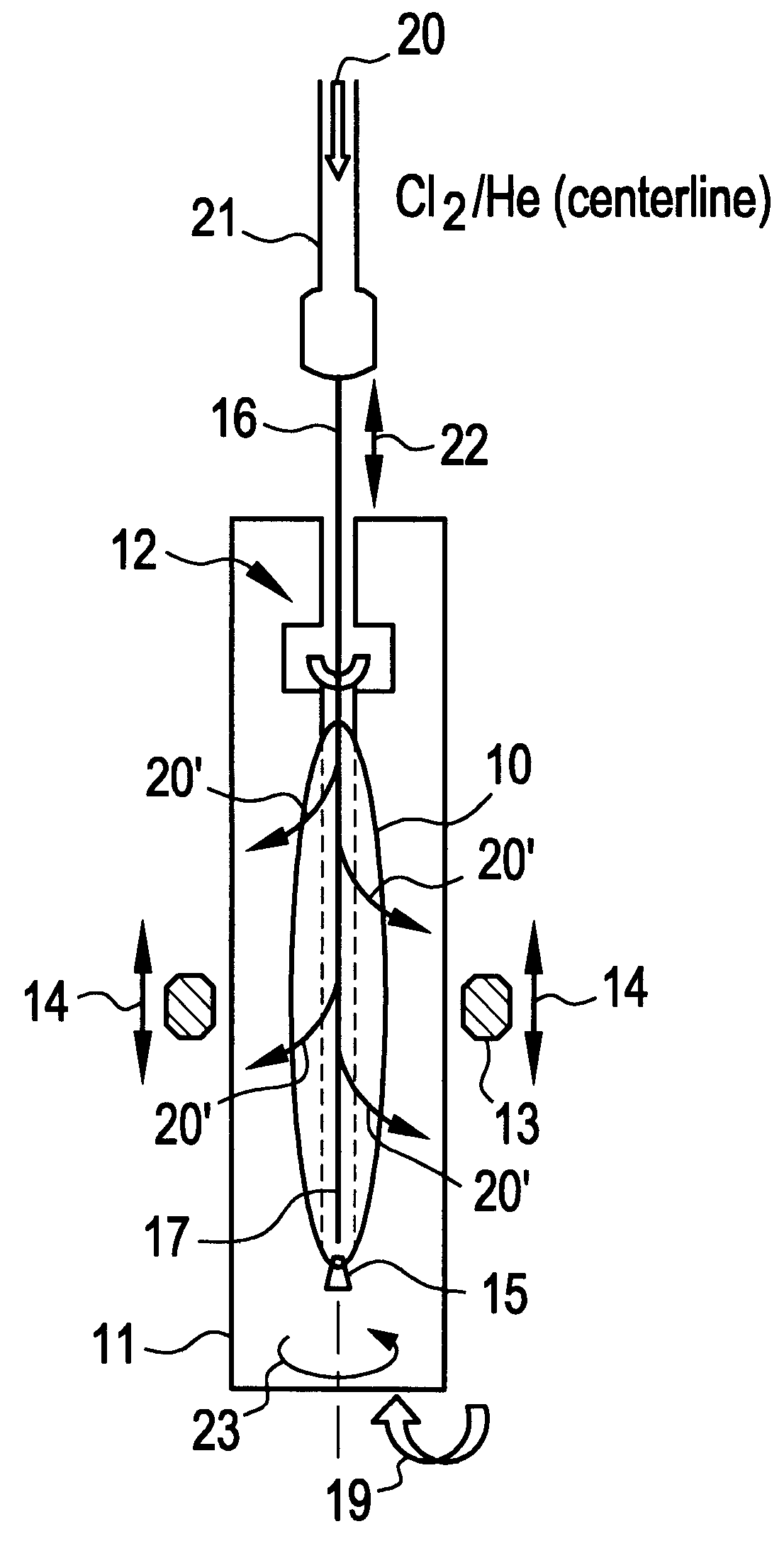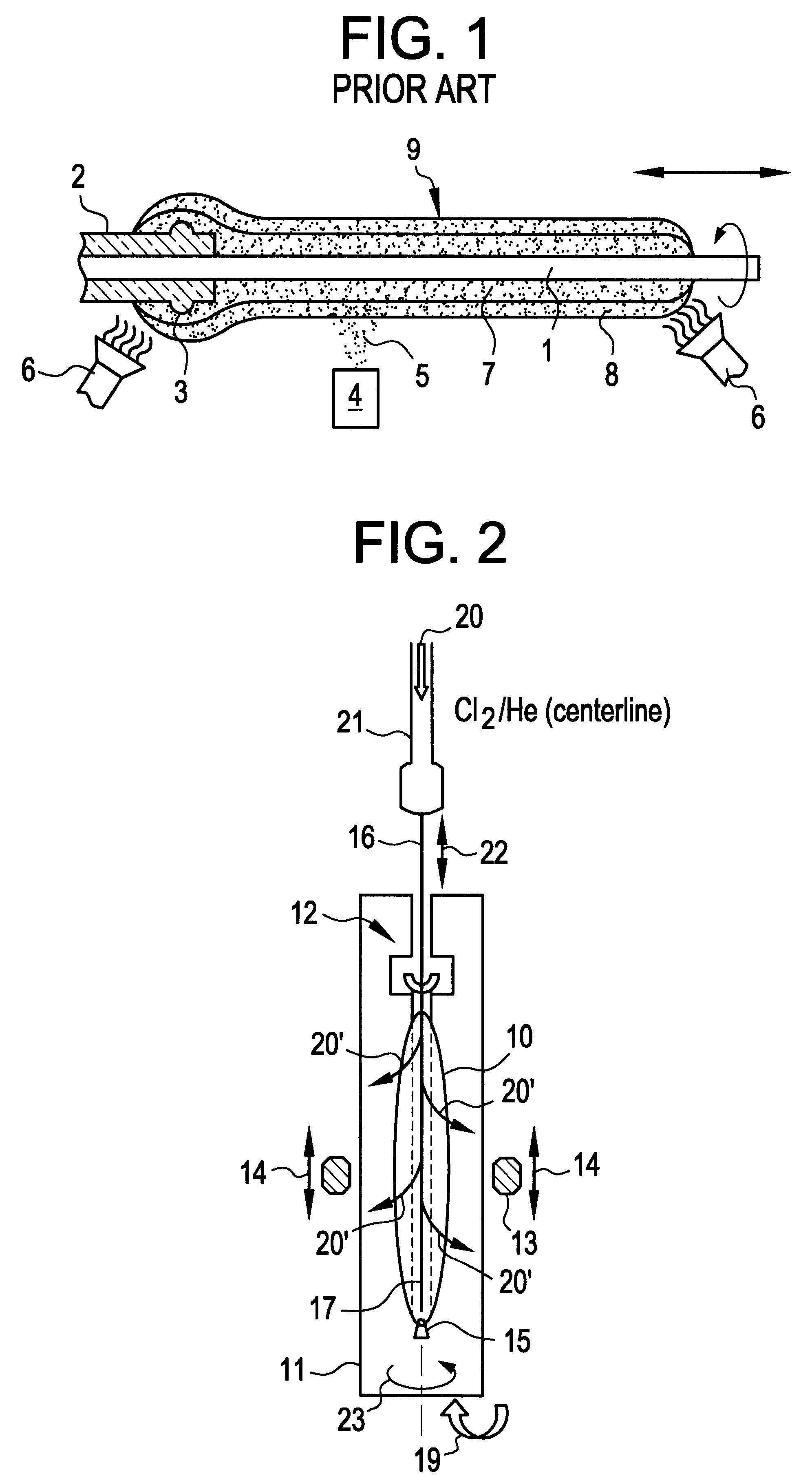Method for controlling dopant profiles
a technology of dopant profiles and dopants, applied in the direction of material analysis using wave/particle radiation, instruments, manufacturing tools, etc., can solve the problems of difficult to deliver rare earth, alumina, other dopants using conventional processes, chemical vapor deposition, etc., and achieve the effect of improving the performance of optical fiber or planar waveguides
- Summary
- Abstract
- Description
- Claims
- Application Information
AI Technical Summary
Benefits of technology
Problems solved by technology
Method used
Image
Examples
example 2
Except for differences specified below, a process similar to Example 1 was used to form an Al.sub.2 O.sub.3 --GeO.sub.2 doped, step index profile optical fiber preform. A soot blank comprising approximately 16 wt % GeO.sub.2 (or double the GeO.sub.2 content as Example 1) was formed using an OVD process. The blank had a bulk density of 0.322 g / cc. During the doping step, the parameters for the gas flow down the centerline line remained the same as in Example 1. However, the upward flow of He gas through the muffle was doubled to 40 slpm and the flow of O.sub.2 through the muffle was omitted. For the 1 hour doping cycle, the furnace temperature was 567.degree. C. at the start of the doping cycle, decreased to 464.degree. C. mid-cycle, and finished at 410.degree. C. by the cycles completion. Almost all of the original 1.106 g of Al wire was consumed during the doping cycle.
FIG. 6 provides the electron microprobe data for a cane of the consolidated and redrawn glass. Referring to FIG. 6...
example 3
Except for the differences specified below, a process similar to Example 1 was used to form an Al.sub.2 O.sub.3 --SiO.sub.2 preform and an Al.sub.2 O.sub.3 --GeO.sub.2 --SiO.sub.2 preform.
For the Al.sub.2 O3--SiO.sub.2 preform, the SiO.sub.2 soot blank, which was formed via an OVD process, had a bulk density of 0.330 g / cc. The doping cycle was conducted for a time duration of 1 hour. The furnace temperature was initially 515.degree. C. at the start of the doping cycle, decreased to 454.degree. C. mid-cycle, and finished at 395.degree. C. at the completion of the cycle. During the doping cycle, a constant downward flow of 35 sccm Cl.sub.2 and 0.32 slpm He gas passed through the furnace handle and along the centerline of the soot blank. At the same time, an upward flow of about 40 slpm He gas passed through the muffle of the furnace. A total of about 1.1035 g of Al wire reacted during the 1 hour doping cycle. The drying and consolidation steps were the same as in Example 1. The consol...
example 4
Except for the differences specified below, a process similar to Example 1 was used to form an Al.sub.2 O.sub.3 --TiO.sub.2 --SiO.sub.2, parabolic profile optical fiber preform. A soot blank comprising approximately 1.5 wt % TiO.sub.2 was formed using an OVD process. The doping cycle was conducted for a time duration of 1 hour. The temperature of the furnace during the doping cycle was approximately between 400.degree. C. and 600.degree. C. During the doping cycle, a downward flow of 35 sccm Cl.sub.2 gas and 0.32 slpm He gas flowed through the centerline and an upward flow of 40 slpm He gas passed through the furnace muffle. Approximately 1.0649 gram of Al reacted during the doping cycle.
The consolidation step consisted of a 1 hour drying step and a shorter time duration sintering step. During the drying step, a continuous flow of 0.9 slpm Cl.sub.2 gas and 9 slpm He gas passed through the muffle. During the sintering step, a continuous flow of 2 slpm O.sub.2 gas and 2 slpm He gas pa...
PUM
| Property | Measurement | Unit |
|---|---|---|
| temperature | aaaaa | aaaaa |
| temperature | aaaaa | aaaaa |
| density | aaaaa | aaaaa |
Abstract
Description
Claims
Application Information
 Login to View More
Login to View More - R&D
- Intellectual Property
- Life Sciences
- Materials
- Tech Scout
- Unparalleled Data Quality
- Higher Quality Content
- 60% Fewer Hallucinations
Browse by: Latest US Patents, China's latest patents, Technical Efficacy Thesaurus, Application Domain, Technology Topic, Popular Technical Reports.
© 2025 PatSnap. All rights reserved.Legal|Privacy policy|Modern Slavery Act Transparency Statement|Sitemap|About US| Contact US: help@patsnap.com



